Abstract
OBJECTIVE: The objective of this study was to analyze a single center's 28-year experience with 1000 living donor transplants. SUMMARY BACKGROUND DATA: The number of potential renal transplant recipients far exceeds the number of cadaveric donors. For this reason, living related donors (LRDs) and, more recently, living unrelated donors (LURDs) have been used to decrease the cadaveric donor shortage. METHODS: From November 15, 1966, until August 5, 1994, 1000 living donor transplants were performed; 906 were living related and 94 were living unrelated transplants. Results were divided into precyclosporine (1966-1986, era I) and cyclosporine (1986-1994, era II) eras. Patient and graft survivals were compared between diabetic and nondiabetic recipients, between LRDs and LURDs, and according to human leukocyte antigen (HLA) matching. Donor mortality, morbidity, and postoperative renal function were also analyzed. RESULTS: The 5-, 10-, and 20-year graft survivals were 78.8%, 64.8%, and 43.4%, respectively. Patient and graft survival improved in era II (patient = 87.0% vs. 81.7%, p = 0.03; graft = 72.9% vs. 67.7%, p = 0.04). Nondiabetic patient and graft survivals were better than diabetic patient survivals in both eras. However, diabetic patient survival improved in era II (78.0% vs. 66.9%, p = 0.04). In era II, HLA-identical recipients had better graft survival than haploidentical or mismatched recipients (91.7% vs. 67.3% and 66.1%, p = 0.01). No difference between haploidentical LRDs and LURDs was seen. One donor death occurred in 1970, and 17% of donors developed postoperative complications. CONCLUSION: Living related and unrelated renal donation continues to be an important source of kidneys for patients with end-stage renal disease.
Full text
PDF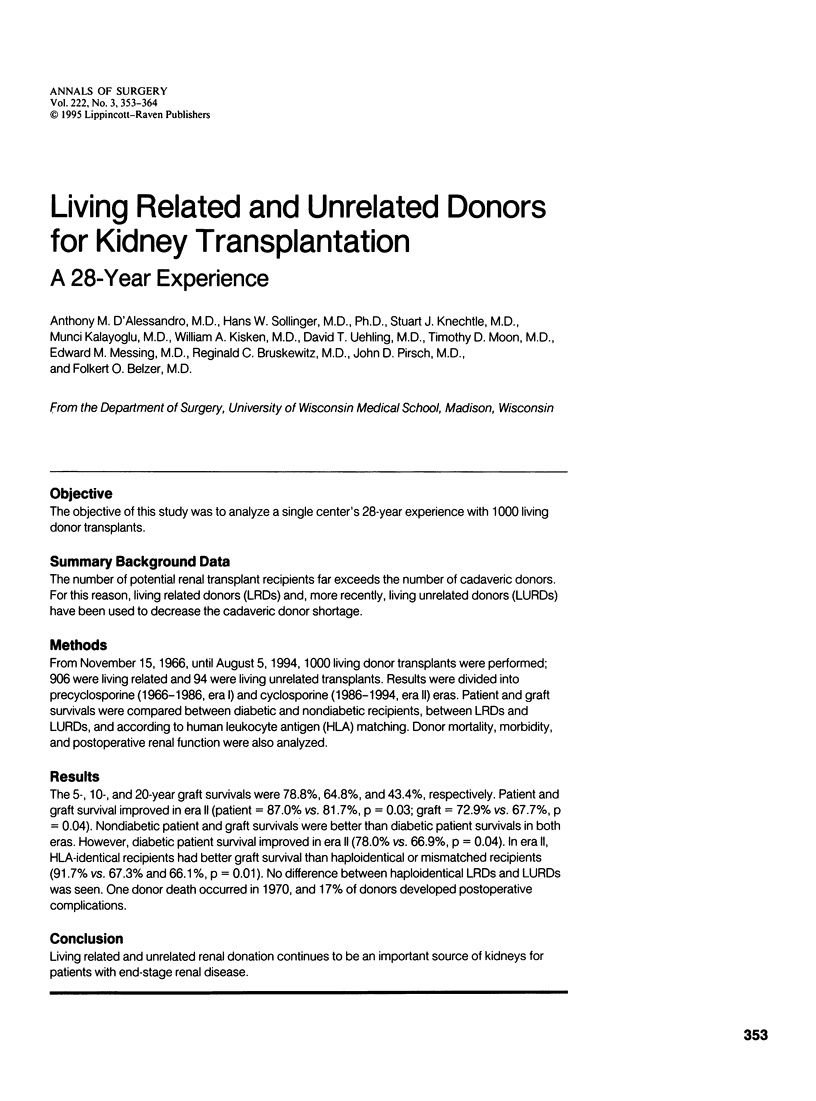
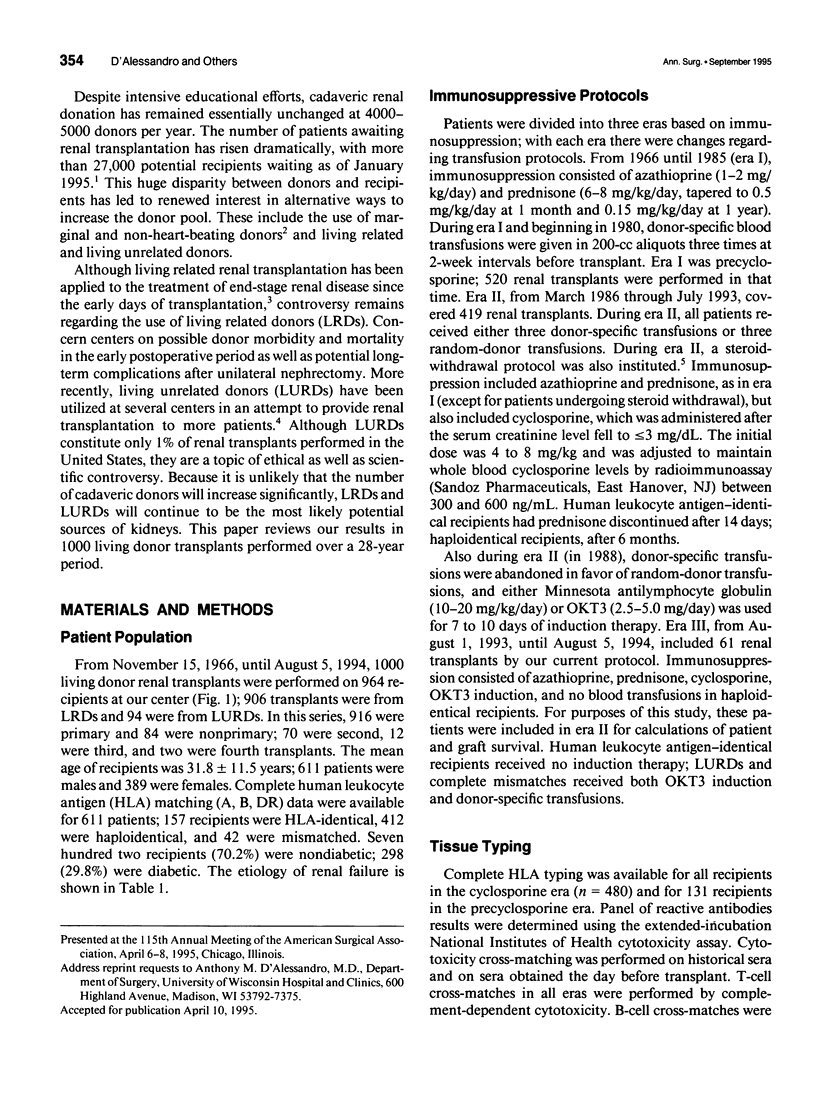
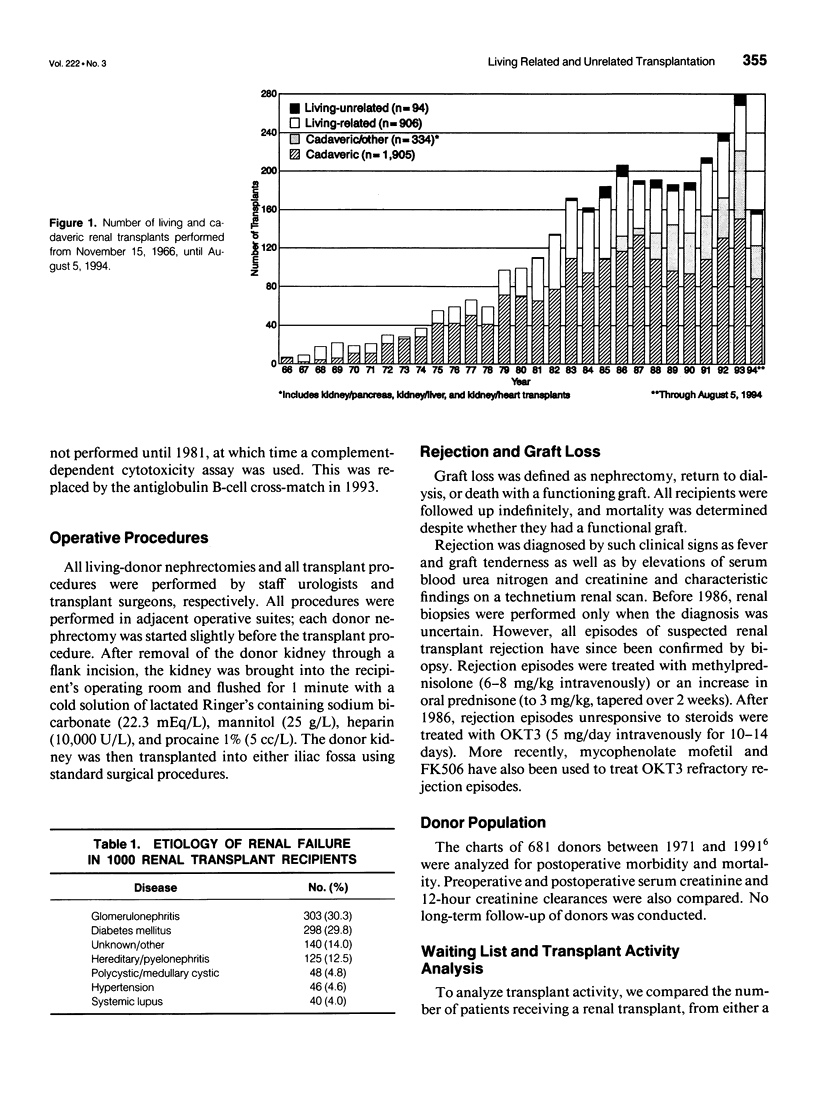
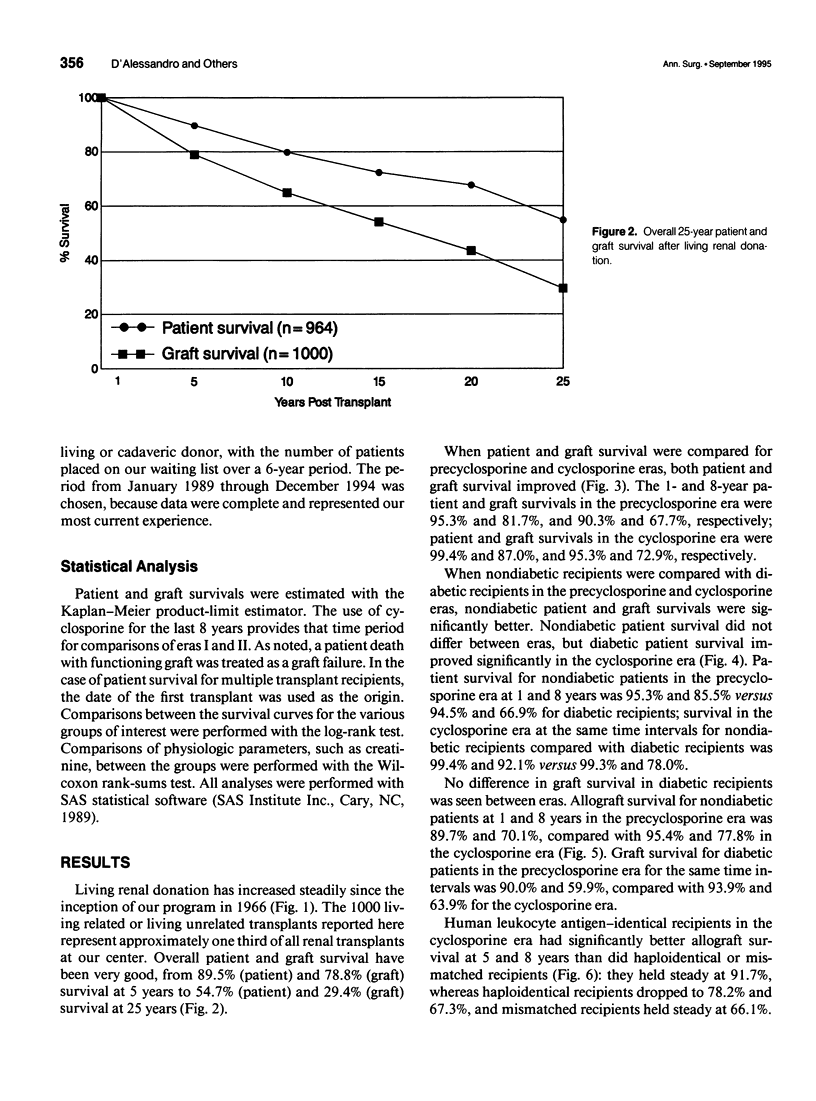

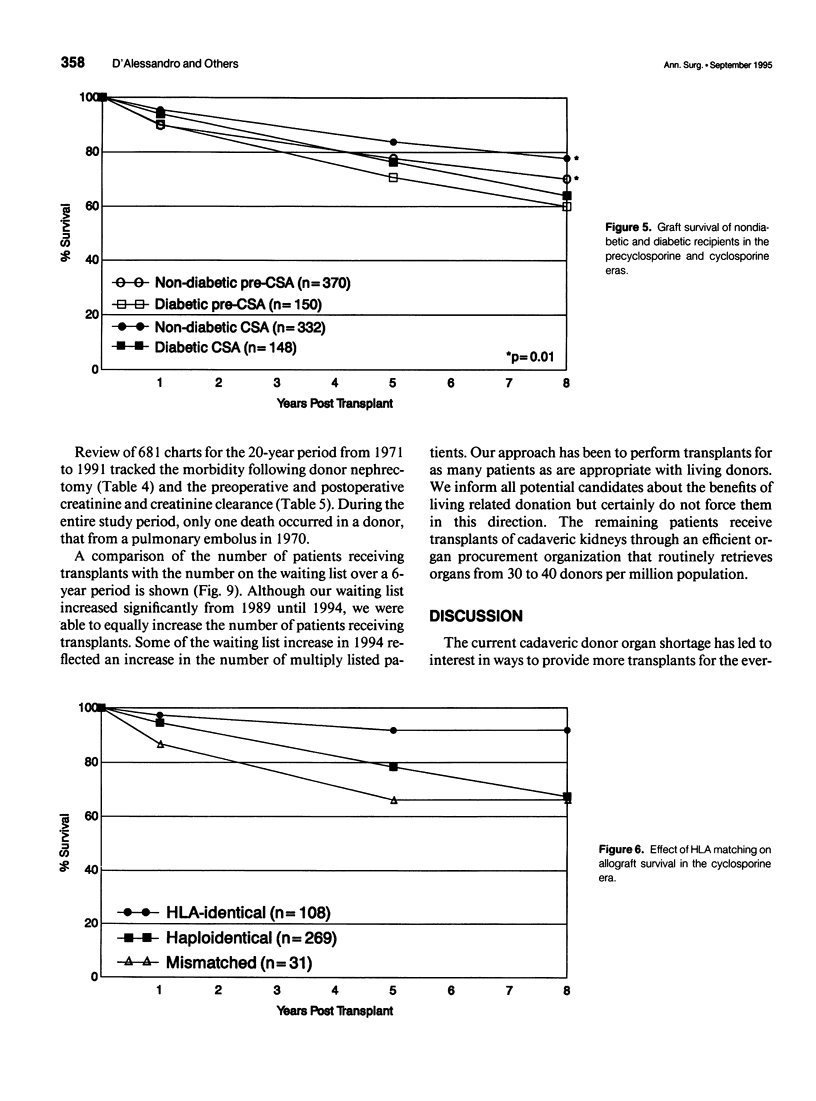
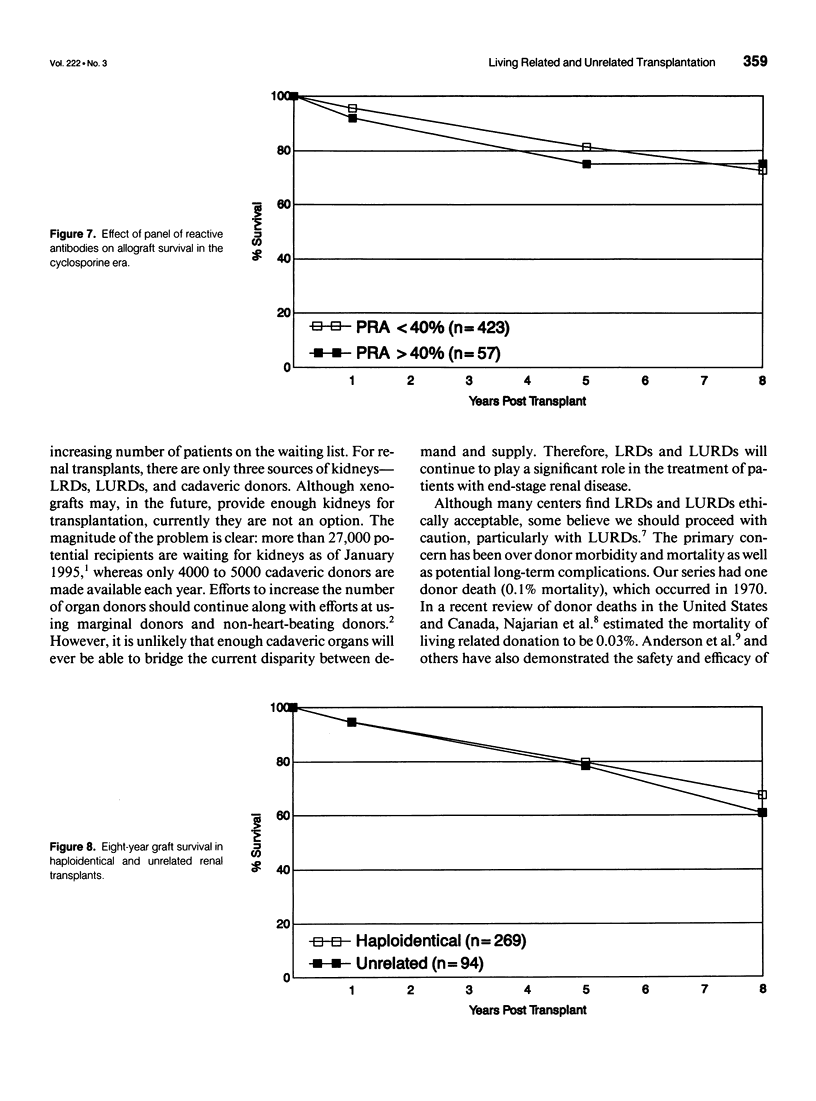
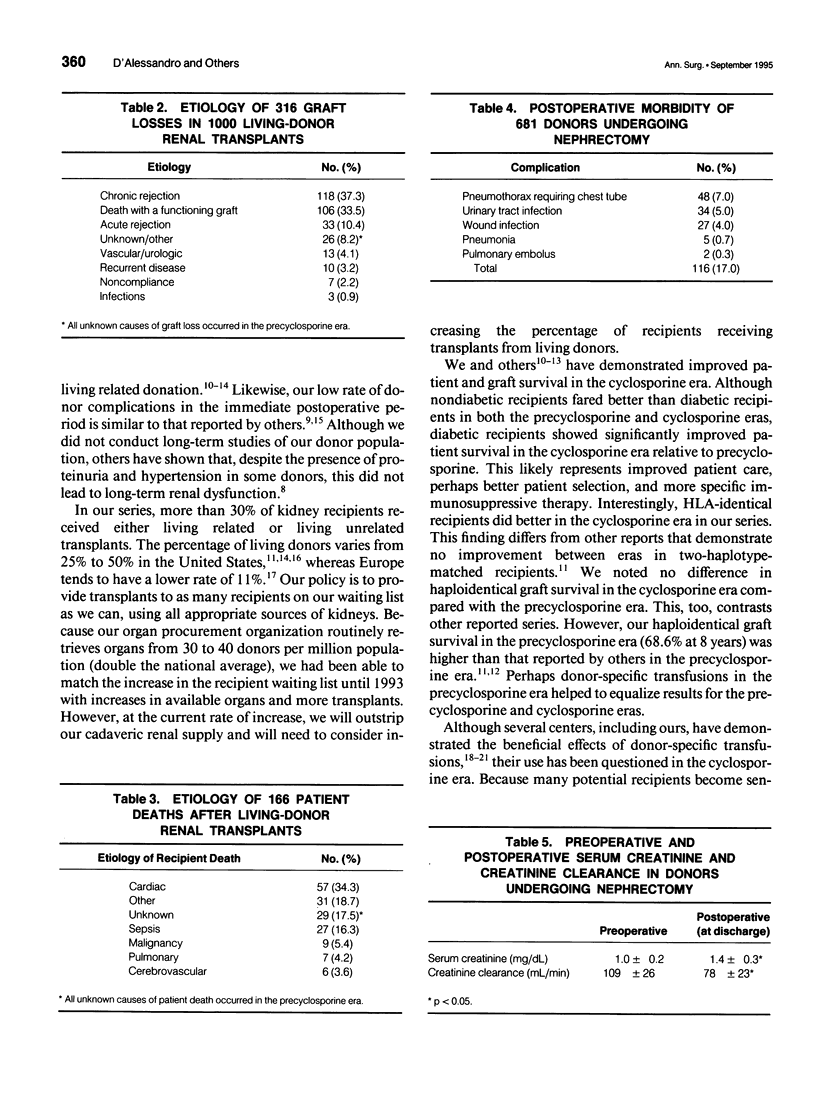
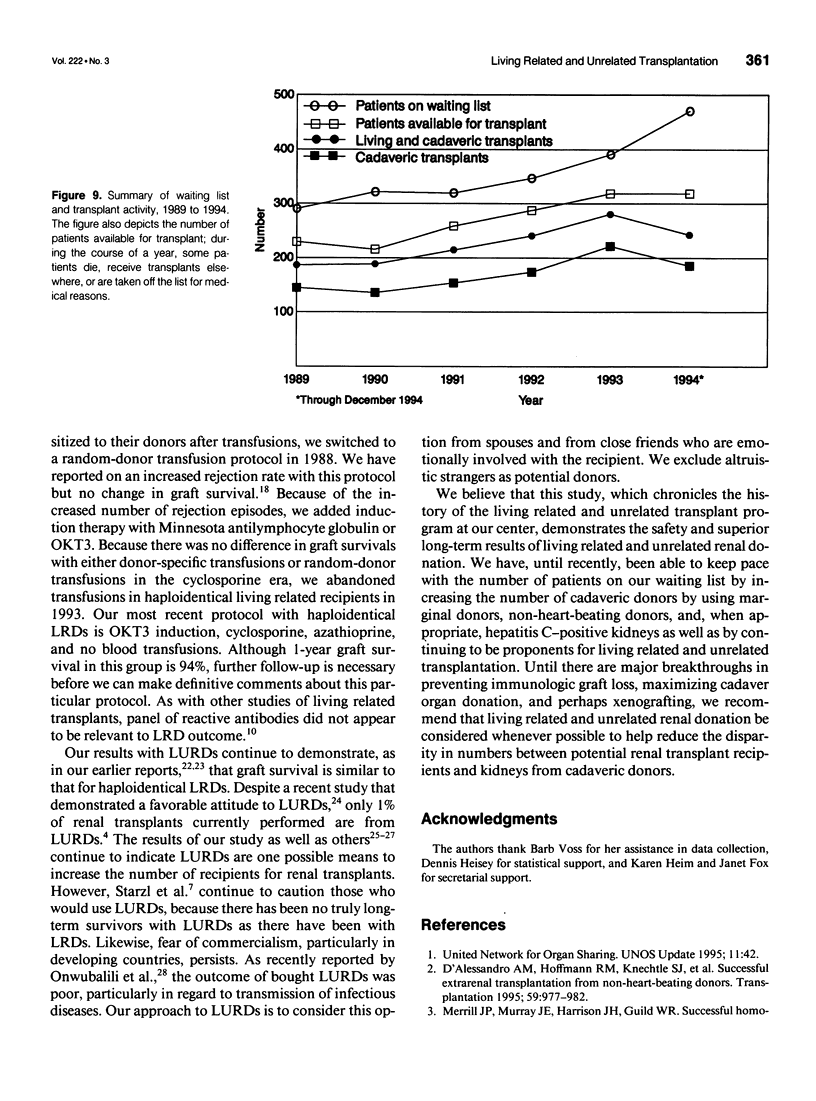
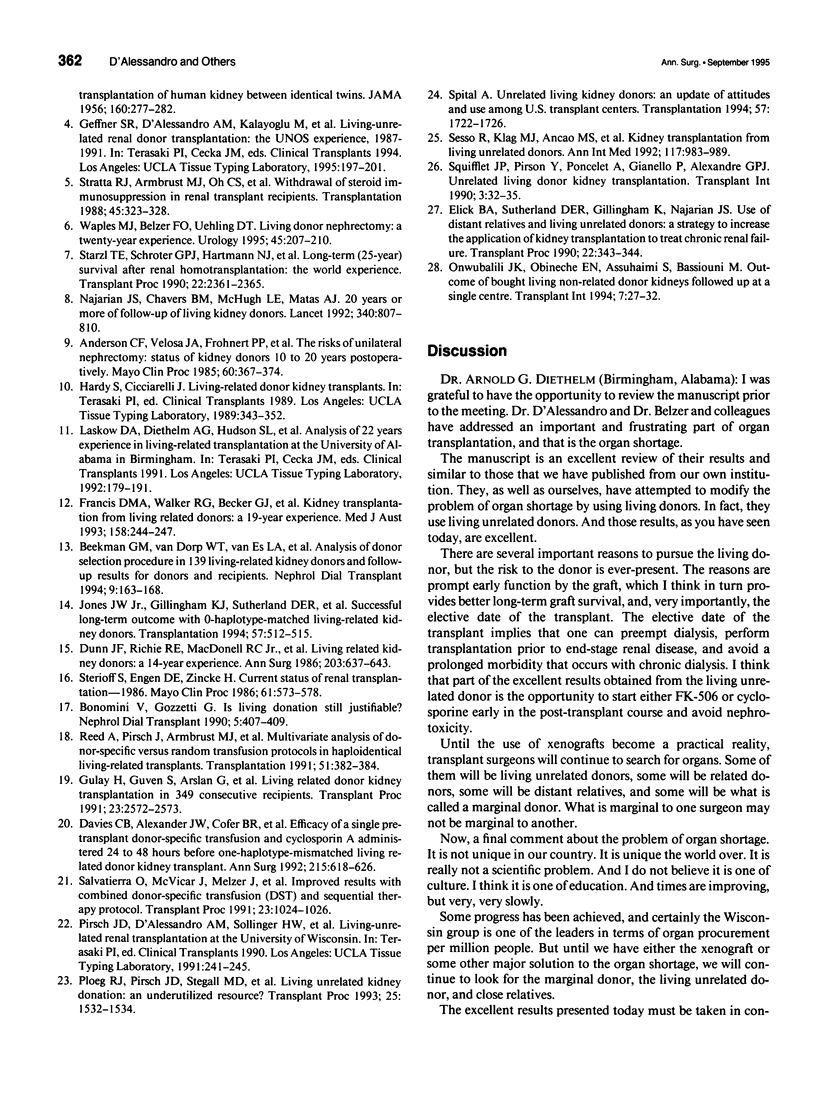
Selected References
These references are in PubMed. This may not be the complete list of references from this article.
- Anderson C. F., Velosa J. A., Frohnert P. P., Torres V. E., Offord K. P., Vogel J. P., Donadio J. V., Jr, Wilson D. M. The risks of unilateral nephrectomy: status of kidney donors 10 to 20 years postoperatively. Mayo Clin Proc. 1985 Jun;60(6):367–374. doi: 10.1016/s0025-6196(12)60845-3. [DOI] [PubMed] [Google Scholar]
- Beekman G. M., van Dorp W. T., van Es L. A., van Bockel J. H., van Saase J. L., van der Woude F. J., Valentijn R. M. Analysis of donor selection procedure in 139 living-related kidney donors and follow-up results for donors and recipients. Nephrol Dial Transplant. 1994;9(2):163–168. [PubMed] [Google Scholar]
- Bonomini V., Gozzetti G. Is living donation still justifiable? Nephrol Dial Transplant. 1990;5(6):407–409. doi: 10.1093/ndt/5.6.407. [DOI] [PubMed] [Google Scholar]
- D'Alessandro A. M., Hoffmann R. M., Knechtle S. J., Eckhoff D. E., Love R. B., Kalayoglu M., Sollinger H. W., Belzer F. O. Successful extrarenal transplantation from non-heart-beating donors. Transplantation. 1995 Apr 15;59(7):977–982. doi: 10.1097/00007890-199504150-00009. [DOI] [PubMed] [Google Scholar]
- Davies C. B., Alexander J. W., Cofer B. R., First M. R., Schroeder T. J. Efficacy of a single pretransplant donor-specific transfusion and cyclosporin A administered 24 to 48 hours before one-haplotype-mismatched living related donor kidney transplant. Ann Surg. 1992 Jun;215(6):618–626. doi: 10.1097/00000658-199206000-00008. [DOI] [PMC free article] [PubMed] [Google Scholar]
- Dunn J. F., Nylander W. A., Jr, Richie R. E., Johnson H. K., MacDonell R. C., Jr, Sawyers J. L. Living related kidney donors. A 14-year experience. Ann Surg. 1986 Jun;203(6):637–643. doi: 10.1097/00000658-198606000-00008. [DOI] [PMC free article] [PubMed] [Google Scholar]
- Elick B. A., Sutherland D. E., Gillingham K., Najarian J. S. Use of distant relatives and living unrelated donors: a strategy to increase the application of kidney transplantation to treat chronic renal failure. Transplant Proc. 1990 Apr;22(2):343–344. [PubMed] [Google Scholar]
- Francis D. M., Walker R. G., Becker G. J., Millar R. J., Powell H. R., Clunie G. J., Kincaid-Smith P. S. Kidney transplantation from living related donors: a 19-year experience. Med J Aust. 1993 Feb 15;158(4):244–247. doi: 10.5694/j.1326-5377.1993.tb121743.x. [DOI] [PubMed] [Google Scholar]
- Geffner S. R., D'Alessandro A. M., Kalayoglu M., Knechtle S. J., Pirsch J. D., Belzer F. O., Sollinger H. W. Living-unrelated renal donor transplantation: the UNOS experience, 1987-1991. United Network for Organ Sharing. Clin Transpl. 1994:197–201. [PubMed] [Google Scholar]
- Gülay H., Güven S., Arslan G., Hamaloğlu E., Ekici E., Bilgin N., Haberal M. Living related donor kidney transplantation in 349 consecutive recipients. Transplant Proc. 1991 Oct;23(5):2572–2573. [PubMed] [Google Scholar]
- Jones J. W., Jr, Gillingham K. J., Sutherland D. E., Payne W. D., Dunn D. L., Gores P. F., Gruessner R. W., Najarian J. S., Matas A. J. Successful long-term outcome with 0-haplotype-matched living-related kidney donors. Transplantation. 1994 Feb 27;57(4):512–515. [PubMed] [Google Scholar]
- Laskow D. A., Diethelm A. G., Hudson S. L., Deierhoi M. H., Barber W. H., Barger B. O., Gaston R. S., Julian B. A., Curtis J. J. Analysis of 22 years experience in living-related transplantation at the University of Alabama in Birmingham. Clin Transpl. 1991:179–191. [PubMed] [Google Scholar]
- MERRILL J. P., MURRAY J. E., HARRISON J. H., GUILD W. R. Successful homotransplantation of the human kidney between identical twins. J Am Med Assoc. 1956 Jan 28;160(4):277–282. doi: 10.1001/jama.1956.02960390027008. [DOI] [PubMed] [Google Scholar]
- Najarian J. S., Chavers B. M., McHugh L. E., Matas A. J. 20 years or more of follow-up of living kidney donors. Lancet. 1992 Oct 3;340(8823):807–810. doi: 10.1016/0140-6736(92)92683-7. [DOI] [PubMed] [Google Scholar]
- Onwubalili J. K., Obineche E. N., Assuhaimi S., Bassiouni M. Outcome of bought living non-related donor kidneys followed up at a single centre. Transpl Int. 1994;7(1):27–32. doi: 10.1007/BF00335660. [DOI] [PubMed] [Google Scholar]
- Pirsch J. D., D'Alessandro A. M., Sollinger H. W., Voss B. J., Knechtle S. J., Reed A., Kalayoglu M., Belzer F. O. Living-unrelated renal transplantation at the University of Wisconsin. Clin Transpl. 1990:241–245. [PubMed] [Google Scholar]
- Ploeg R. J., Pirsch J. D., Stegall M. D., Armbrust M. J., Lorentzen D. F., D'Alessandro A. M., Knechtle S. J., Sollinger H. W., Kalayoglu M., Belzer F. O. Living unrelated kidney donation: an underutilized resource? Transplant Proc. 1993 Feb;25(1 Pt 2):1532–1534. [PubMed] [Google Scholar]
- Reed A., Pirsch J., Armbrust M. J., Burlingham W. J., Knechtle S. J., D'Alessandro A. M., Sollinger H. W., Lorentzen D., Kalayoglu M., Belzer F. O. Multivariate analysis of donor-specific versus random transfusion protocols in haploidentical living-related transplants. Transplantation. 1991 Feb;51(2):382–384. doi: 10.1097/00007890-199102000-00022. [DOI] [PubMed] [Google Scholar]
- Salvatierra O., McVicar J., Melzer J., Amend W., Vincenti F., Tomlanovich S., Husing R., Rabkin J., Garovoy M. Improved results with combined donor-specific transfusion (DST) and sequential therapy protocol. Transplant Proc. 1991 Feb;23(1 Pt 2):1024–1026. [PubMed] [Google Scholar]
- Sesso R., Klag M. J., Ancao M. S., Whelton P. K., Seidler A., Sigulem D., Ramos O. L. Kidney transplantation from living unrelated donors. Ann Intern Med. 1992 Dec 15;117(12):983–989. doi: 10.7326/0003-4819-117-12-983. [DOI] [PubMed] [Google Scholar]
- Spital A. Unrelated living kidney donors. An update of attitudes and use among U.S. transplant centers. Transplantation. 1994 Jun 27;57(12):1722–1726. [PubMed] [Google Scholar]
- Squifflet J. P., Pirson Y., Poncelet A., Gianello P., Alexandre G. P. Unrelated living donor kidney transplantation. Transpl Int. 1990 May;3(1):32–35. doi: 10.1007/BF00333200. [DOI] [PubMed] [Google Scholar]
- Starzl T. E., Schroter G. P., Hartmann N. J., Barfield N., Taylor P., Mangan T. L. Long-term (25-year) survival after renal homotransplantation--the world experience. Transplant Proc. 1990 Oct;22(5):2361–2365. [PMC free article] [PubMed] [Google Scholar]
- Sterioff S., Engen D. E., Zincke H. Current status of renal transplantation--1986. Mayo Clin Proc. 1986 Jul;61(7):573–578. doi: 10.1016/s0025-6196(12)62007-2. [DOI] [PubMed] [Google Scholar]
- Stratta R. J., Armbrust M. J., Oh C. S., Pirsch J. D., Kalayoglu M., Sollinger H. W., Belzer F. O. Withdrawal of steroid immunosuppression in renal transplant recipients. Transplantation. 1988 Feb;45(2):323–328. doi: 10.1097/00007890-198802000-00015. [DOI] [PubMed] [Google Scholar]
- Waples M. J., Belzer F. O., Uehling D. T. Living donor nephrectomy: a 20-year experience. Urology. 1995 Feb;45(2):207–210. doi: 10.1016/0090-4295(95)80006-9. [DOI] [PubMed] [Google Scholar]


